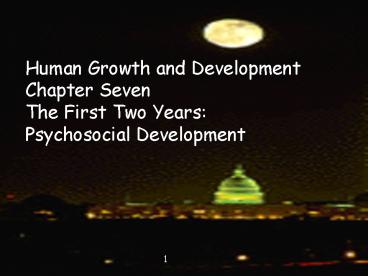Human Growth and Development Chapter Seven The First Two Years: Psychosocial Development
1 / 31
Title:
Human Growth and Development Chapter Seven The First Two Years: Psychosocial Development
Description:
Freud: Oral and Anal Stages. Oral Stage 1st stage, where infant obtains pleasure ... After a few weeks, see curiosity/interest, social smile, and laughter ... –
Number of Views:256
Avg rating:3.0/5.0
Title: Human Growth and Development Chapter Seven The First Two Years: Psychosocial Development
1
Human Growth and DevelopmentChapter SevenThe
First Two YearsPsychosocial Development
2
Theories About Early Psychosocial Development
- Psychoanalytic Theory
- Behaviorism Theory
- Cognitive Theory
- Epigenetic Theory
- Sociocultural Theory
3
Psychoanalytic Theory
- Connects biosocial and psychosocial development
4
Freud Oral and Anal Stages
- Oral Stage1st stage, where infant obtains
pleasure through mouth - Anal Stage2nd stage, where anus becomes main
source of gratification
5
Erikson Trust and Autonomy
- 1st StageTrust vs. Mistrust
- basic needs need to be met with consistency,
continuity, and sameness - 2nd StageAutonomy vs. Shame and Doubt
- basic desire to gain self-rule over their own
actions and bodies with parental guidance
6
Behaviorism
- Infants emotions and personality are molded as
parents reinforce or punish childs spontaneous
behavior
7
Cognitive Theory
- Individuals thoughts and perceptions determine
perspective on the world Working modelset of
assumptions used to organize perceptions and
experiences
8
Epigenetic Theory
- Each child is born with a genetic predisposition
to develop certain traits that affect emotional
development - Temperamentgenetically based individual
differences in emotions, activity, and
self-control which lead to behavioral tendencies - epigeneticthough traits not learned, environment
affects their expression
9
Research on Temperament Nine Infant
Characteristics
- activity level
- rhythmicity/schedule
- approach-withdrawal to new
- adaptability to new
- intensity of reaction
- threshold of responsiveness to sensations
- quality of mood
- distractibility
- attention span
- see these by 2-3 mos. of age
10
Temperament and Caregiving
- Most (50) are easy
- Responsive care and encouragement can help
inhibited children become less so - Goodness of fitparent adjusts to match
temperament of child - Lead to better development if good fit
- With slow to warmgive time to adjust
- With easy, happymake sure safe as explore
- With difficultpatiently guide them and build
positive interactions
11
Sociocultural Theory
- Social context can have impact on
infant-caregiver relationship and childs
development
12
Emotions The First Year
- Newborns first emotions
- Distress
- Contentment
- After a few weeks, see curiosity/interest, social
smile, and laughter - Later emotions (after first few months)
- Angerif frustrated
- Fear, expressed clearly by stranger wariness and
separation anxiety (9-14 mos.)
13
The Second Year
- Fear and anger typically decrease
- Laughing, crying more discriminating
- New emotions appear
- pride
- shame
- embarrassment
- guilt
14
(No Transcript)
15
Self-Awareness
- Foundation for emotional growth
- realization of self as distinct individual with
separate thoughts and actions from others
16
(No Transcript)
17
Synchrony
- Synchronycoordinated interaction between infant
and caregivergood timing
18
Attachment
- Enduring emotional connection or bond between 2
people - Show attachment through
- Proximity-seeking behaviors
- Contact-maintaining behaviors
19
Secure and Insecure Attachment
- Bowlby and Ainsworth
- Secure (B)relationship of trust and confidence
that provides comfort, assurance, and secure base - Are close to caregiver but ready to explore
20
- Insecurerelationship that is unpredictable or
unstable infant shows fear, anxiety, anger or
indifference to caregiver because trying to
adjust to caretaker who ignores or is
overprotective or inconsistent
21
- Avoidant (A) one person tries to avoid any
connection with another infant doesnt check
with parent - Resistant/ambivalent (C) anxiety and uncertainly
keep one person clinging to another infant
clings and not want to leave but also pushes away - Disorganized (D)marked by inconsistent behavior
of caregiver and infant toward each other
22
23
Measuring Attachment
- Strange Situationlab procedure to measure
attachment observed are - exploration of the toys (caregiver present)
- reaction to caregivers departure
- reaction to caregivers return
- 2/3 are secure 1/3 insecure
- Insecure greater with depressed mothers
- Insecure can become secure, but fairly stable
24
(No Transcript)
25
(No Transcript)
26
(No Transcript)
27
Social Referencing
- Looking to others for cues
- Look to mother for comfort
- Mothers tone and expression can become guide to
how to react to unfamiliar or ambiguous event
28
- Infants look to fathers for fun and physical play
because fathers play more than mothers - Physically active play with fathers may
contribute to development of social skills and
emotional expression - Physically active play with fathers helps
children master motor skills and develop muscle
control
29
Infant Day-Care
- High-quality programs include
- adequate attention to each infant
- encouragement of sensorimotor exploration and
language development - attention to health and safety
- well-trained professional caregivers
30
(No Transcript)
31
(No Transcript)































